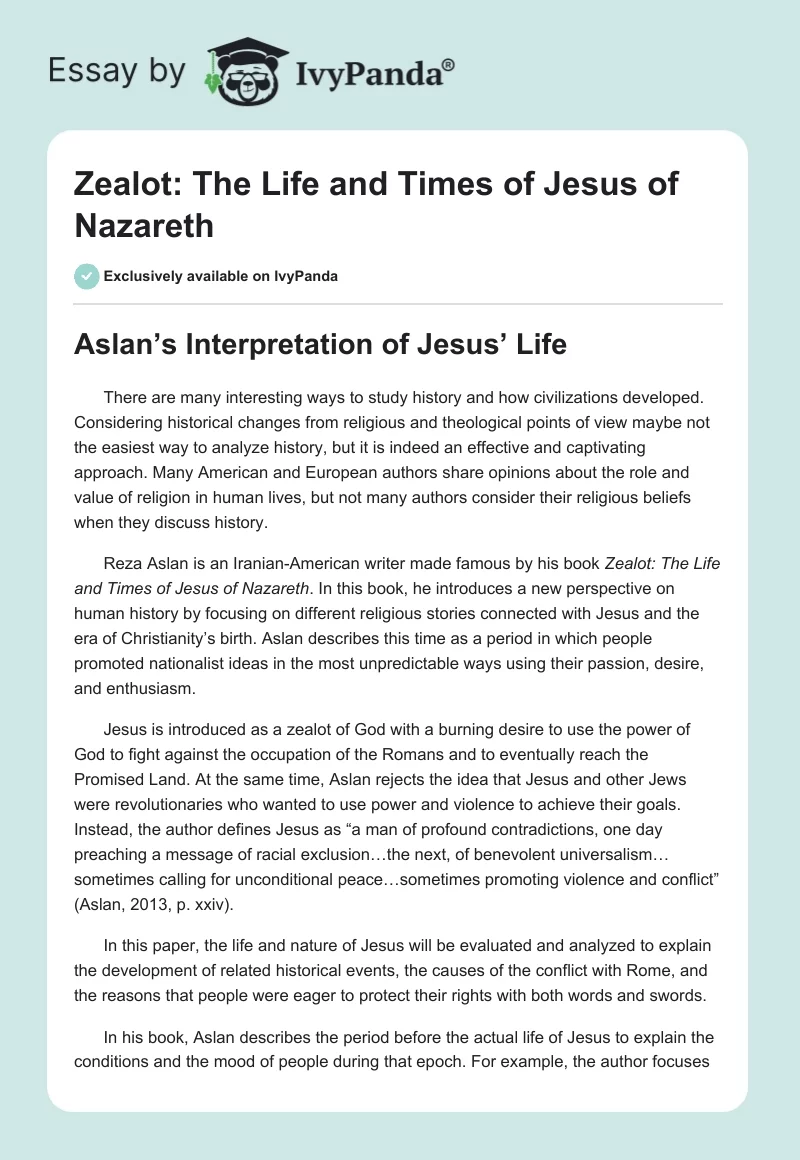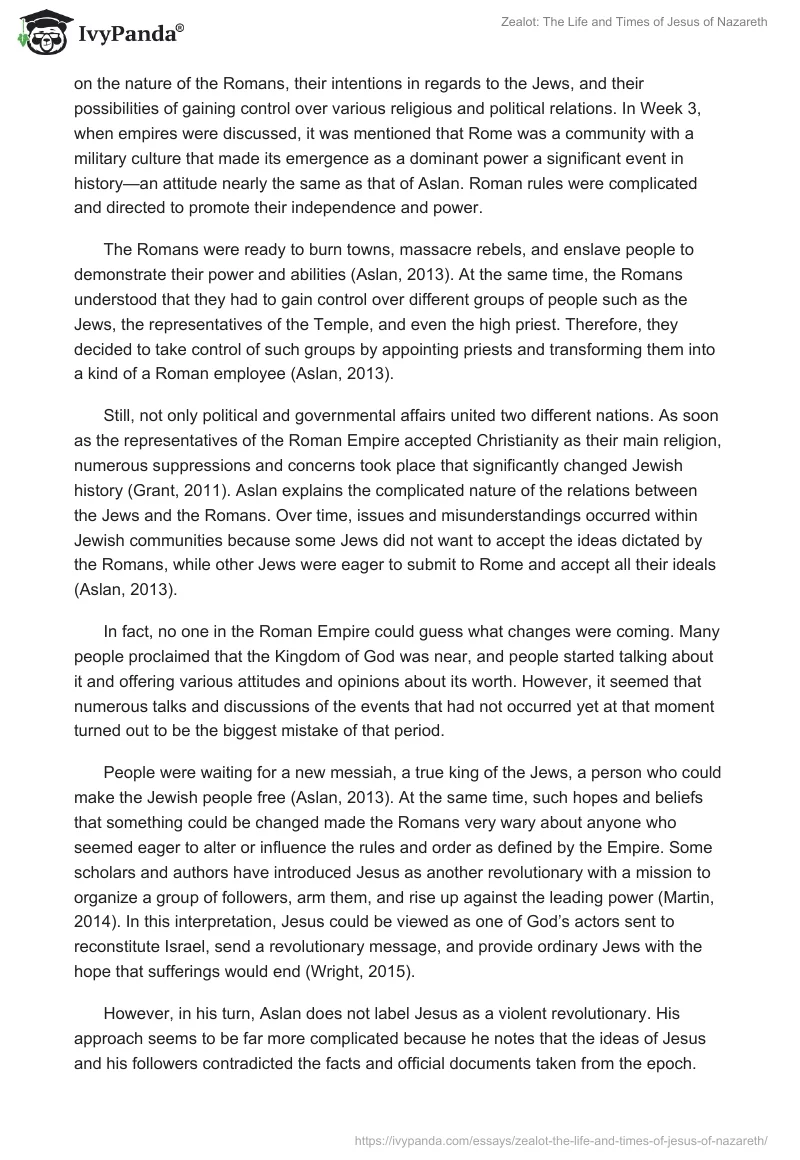Aslan’s Interpretation of Jesus’ Life
There are many interesting ways to study history and how civilizations developed. Considering historical changes from religious and theological points of view maybe not the easiest way to analyze history, but it is indeed an effective and captivating approach. Many American and European authors share opinions about the role and value of religion in human lives, but not many authors consider their religious beliefs when they discuss history.
Reza Aslan is an Iranian-American writer made famous by his book Zealot: The Life and Times of Jesus of Nazareth. In this book, he introduces a new perspective on human history by focusing on different religious stories connected with Jesus and the era of Christianity’s birth. Aslan describes this time as a period in which people promoted nationalist ideas in the most unpredictable ways using their passion, desire, and enthusiasm.
Jesus is introduced as a zealot of God with a burning desire to use the power of God to fight against the occupation of the Romans and to eventually reach the Promised Land. At the same time, Aslan rejects the idea that Jesus and other Jews were revolutionaries who wanted to use power and violence to achieve their goals. Instead, the author defines Jesus as “a man of profound contradictions, one day preaching a message of racial exclusion…the next, of benevolent universalism…sometimes calling for unconditional peace…sometimes promoting violence and conflict” (Aslan, 2013, p. xxiv).
In this paper, the life and nature of Jesus will be evaluated and analyzed to explain the development of related historical events, the causes of the conflict with Rome, and the reasons that people were eager to protect their rights with both words and swords.
In his book, Aslan describes the period before the actual life of Jesus to explain the conditions and the mood of people during that epoch. For example, the author focuses on the nature of the Romans, their intentions in regards to the Jews, and their possibilities of gaining control over various religious and political relations. In Week 3, when empires were discussed, it was mentioned that Rome was a community with a military culture that made its emergence as a dominant power a significant event in history—an attitude nearly the same as that of Aslan. Roman rules were complicated and directed to promote their independence and power.
The Romans were ready to burn towns, massacre rebels, and enslave people to demonstrate their power and abilities (Aslan, 2013). At the same time, the Romans understood that they had to gain control over different groups of people such as the Jews, the representatives of the Temple, and even the high priest. Therefore, they decided to take control of such groups by appointing priests and transforming them into a kind of a Roman employee (Aslan, 2013).
Still, not only political and governmental affairs united two different nations. As soon as the representatives of the Roman Empire accepted Christianity as their main religion, numerous suppressions and concerns took place that significantly changed Jewish history (Grant, 2011). Aslan explains the complicated nature of the relations between the Jews and the Romans. Over time, issues and misunderstandings occurred within Jewish communities because some Jews did not want to accept the ideas dictated by the Romans, while other Jews were eager to submit to Rome and accept all their ideals (Aslan, 2013).
In fact, no one in the Roman Empire could guess what changes were coming. Many people proclaimed that the Kingdom of God was near, and people started talking about it and offering various attitudes and opinions about its worth. However, it seemed that numerous talks and discussions of the events that had not occurred yet at that moment turned out to be the biggest mistake of that period.
People were waiting for a new messiah, a true king of the Jews, a person who could make the Jewish people free (Aslan, 2013). At the same time, such hopes and beliefs that something could be changed made the Romans very wary about anyone who seemed eager to alter or influence the rules and order as defined by the Empire. Some scholars and authors have introduced Jesus as another revolutionary with a mission to organize a group of followers, arm them, and rise up against the leading power (Martin, 2014). In this interpretation, Jesus could be viewed as one of God’s actors sent to reconstitute Israel, send a revolutionary message, and provide ordinary Jews with the hope that sufferings would end (Wright, 2015).
However, in his turn, Aslan does not label Jesus as a violent revolutionary. His approach seems to be far more complicated because he notes that the ideas of Jesus and his followers contradicted the facts and official documents taken from the epoch. The author argues that there is one fact that cannot be denied: “Jesus was crucified by Rome because his messianic aspirations threatened the occupation of Palestine, and his zealotry endangered the Temple authorities” (Aslan, 2013, p. 69).
In the mind of believers, the Kingdom of God was an evident fact. Still, it was hard for the Roman authorities to comprehend the nature of that kingdom, the intentions of its inhabitants, and the possible outcomes and results. The attitude of the Roman Empire to that kingdom was clear: the organization formed by Jesus was new, uncontrollable, and even aggressive because people did not want to accept Roman orders and instead wanted to introduce their ideas and beliefs by any possible means.
From a political point of view, the majority of Rome’s actions make sense, as they were used as a way to identify a threat and destroy it in a short period of time. Still, it is hard to understand whether crucifixion was the answer to any kind of sedition in Rome, and the gospels that serve as one of the primary sources of Jesus’ life do not give a clear answer.
Taking into consideration the facts and examples discussed in the book, Jesus fits into the context of class discussions in a variety of ways. For example, Jesus was a serious political figure who could unite a number of people through both their religious beliefs and their attitudes towards the local powers. He was able to gather people’s opinions and introduce his message in the most effective way. People were ready to listen to him and follow him.
Another point of the book is the description of the opportunities and challenges people actually have. Jesus, as well as his followers, faced a number of challenges in delivering their messages in a clear and comprehensive way. Many people did not want to accept the truth from a “group of illiterate peasants from the backwoods of Galilee whose only experience with the scriptures was what little they heard of them in their synagogues back home” (Aslan, 2013, p.131).
In general, Aslan makes a compelling argument for his interpretation of the life of Jesus, his intentions, and methods. Though Jesus’ lasting effect on history or politics can be debated, his role as a charismatic and compelling figure who inspired deep affection and belief undoubtedly changed the history and development of religion worldwide.
References
Aslan, R. (2013). Zealot: The life and times of Jesus of Nazareth. New York, NY: Random House.
Grant, M. (2011). Jews in the Roman world. London, UK: Orion Books.
Martin, D. B. (2014). Jesus in Jerusalem: Armed and Not Dangerous. Journal for the Study of the New Testament, 37(1), 3-24.
Wright, N.T. (2015). The challenge of Jesus: Rediscovering who Jesus was and is. Downers Grove, IL: InterVarsity Press.


